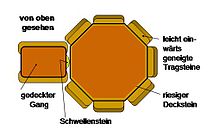Runddysse in Klosterris Hegn
The Runddysse in Klosterris Hegn is about 500 meters from Hornbækvej in the north of Klosterris Hegn (Forest), south of Hornbæk in Helsingør Kommune on the Danish island of Zealand and is a free-standing polygonal spar as a remnant of an original Runddysse. The dolmen dates from the Neolithic around 3500–2800 BC. And is a megalithic system of the funnel beaker culture (TBK). It was registered as early as 1884 and protected in 1942. The dolmen is especially notable for its huge capstone. Immediately to the north, two large stone collections have been registered as potential remains of megalithic systems.
In the eastern part of Klosterris Hegn, near Hornbækvejen, there are two Langdysser. A 2.0 meter high with the hill dimensions 19 × 7 m lies in the south. It has 17 preserved curbs, five of which are in situ. The largest is more than two feet high. At the southwest end of the hill there are the remains of a burial chamber, at the opposite end a completely lost chamber. The long hill was placed under protection in 1942.
About one kilometer to the north is a more disturbed long dyssey. The hill measures approximately 16.0 × 10.0 m and has preserved curbs. At one end is the pit of a distant burial chamber.
See also
literature
- Peter V. Glob : prehistoric monuments of Denmark. Wachholtz, Neumünster 1968
Individual evidence
- ↑ Runddysse is the common denomination in Denmark for dolmens that are located in a round hill. In contrast, Langdysser are those dolmen that are located in a rectangular or trapezoidal barn bed
Web links
Description and pictures (Danish) Description and picture (Danish)
Coordinates: 56 ° 4 ′ 25 ″ N , 12 ° 26 ′ 57 ″ E

